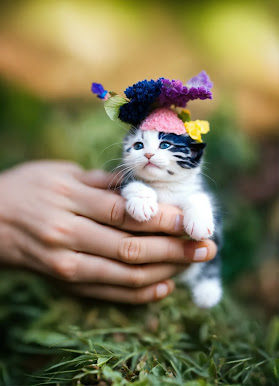Communicating with your cat effectively can be a game-changer, strengthening the bond between you and ensuring a more harmonious home. Understanding and reciprocating your cat’s unique ways of expressing itself is key. In this comprehensive guide, we'll explore the subtleties of feline communication, helping you and your cat understand each other better.
- Decoding Feline Body Language
1. Tail Signals:
A cat’s tail is one of the most expressive parts of its body.
- Straight Up: Indicates friendliness and confidence.
- Puffed Up: Sign of fear or aggression.
- Tucked Under: Suggests submission or anxiety.
- Gentle Sweep: Shows curiosity or interest.
- Rapid Flicking: Sign of agitation or excitement.
2. Ear Positions:
Ears reveal much about a cat's mood.
- Forward and Erect: Indicates alertness or interest.
- Flat and Backward: A sign of fear, anger, or aggression.
- Swiveling: The cat is trying to pinpoint or track a sound.
3. Eyes:
Eyes can convey trust, stress, contentment, and fear.
- Slow Blinking: A sign of trust and affection. Slow-blink back to reassure your cat.
- Dilated Pupils: Can indicate excitement, fear, or surprise.
- Half-Closed Eyes: Usually signifies relaxation and contentment.
- Understanding Vocalizations
Cats often talk through their meows, purrs, and other sounds.
1. Meowing:
Cats usually meow to communicate with humans.
- Short Meow: Typical greeting.
- Repeated Meows: Excitement, often seen when greeting you after a period of separation.
- Low-Pitched Meows: Signal complaints or displeasure.
- High-Pitched Meows: Can indicate urgency or the need for attention.
2. Purring:
While typically a sign of contentment, purring can also occur when a cat is in pain or feeling anxious, acting as a self-soothing mechanism.
3. Hissing and Growling:
These sounds are clear indicators of fear or aggression. It’s best to give your cat space when they hiss or growl.
- Building Better Communication
1. Respect Their Space:
Cats are naturally territorial. Always respect your cat’s personal space to build trust and prevent stress.
2. Play and Interaction:
Engage in interactive play to strengthen your bond. Use toys that mimic prey to stimulate their hunting instincts and provide mental stimulation.
3. Positive Reinforcement:
Reward desired behavior with treats and affection. Positive reinforcement helps your cat associate certain behaviors with positive outcomes, making communication easier.
4. Consistency and Routine:
Cats thrive on routine. Establishing consistent feeding and playtimes helps your cat feel more secure and understand what to expect from you.
- Advanced Communication Techniques
1. Training:
Cats can be trained using positive reinforcement methods such as clicker training. Teaching simple commands enhances communication and provides mental stimulation.
2. Observing Individual Preferences:
Each cat has its own personality and preferences. Spend time observing your cat to understand their likes and dislikes, tailoring your communication style accordingly.
- Hands-On Techniques
1. Petting and Physical Affection:
Learn where your cat likes to be petted. Some cats prefer chin scratches, while others enjoy being stroked along their backs. Observe their reactions to tailor your approach.
2. Grooming Sessions:
Regular grooming can be a bonding experience and helps keep your cat’s coat healthy. Start with short sessions and gradually increase the duration as your cat becomes more comfortable.
3. Eye Contact:
Use slow blinks to communicate trust. Avoid direct, prolonged stares, as they can be perceived as threatening.
- Avoiding Common Mistakes
1. Misreading Body Language:
Misinterpreting your cat’s signals can lead to stress and discomfort. Pay close attention to their body language to understand their needs better.
2. Physical Punishment:
Never punish your cat physically. It damages the trust and can lead to behavioral issues. Instead, use positive reinforcement to encourage good behavior.
3.Overstimulating:
Cats can become overstimulated quickly, especially during petting. Watch for signs such as tail flicking or skin twitching and stop if your cat shows discomfort.
- Conclusion
Effective communication with your cat involves understanding their unique body language, vocal cues, and individual preferences. By focusing on these aspects and using positive reinforcement, you can build a stronger, more trusting relationship with your feline friend. Remember, patience and observation are key in deciphering the intricate language of cats. With this comprehensive guide, you are well on your way to becoming a proficient communicator and a better companion to your cat.
Keywords: communicate with your cat, feline body language, cat vocalizations, understanding your cat, cat communication guide.
.webp)
.webp)

